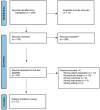Treatment of Ankyloglossia: A Review
- PMID: 38002899
- PMCID: PMC10670877
- DOI: 10.3390/children10111808
Treatment of Ankyloglossia: A Review
Abstract
Aim: The aim of this narrative review is to analyze and compare the current scientific evidence regarding the diagnosis and treatment of hypertrophic lingual frenulum in preschool and school-age children. The treatments considered in this review are traditional surgical therapy, laser-assisted surgical therapy, and functional rehabilitation therapy.
Materials and methods: A comprehensive literature review was conducted using the PubMed and PubMed Central search engines, considering articles published in the English language between 1 January 2000 and 30 June 2022. The bibliographic search was performed using the following keywords as search strings: "lingual", "frenulectomy", "frenulotomy", "frenulum", "ankyloglossia", and "laser."
Results: A total of 14 articles were included in this review, including four prospective observational studies, one case-control study, three cross-sectional studies, four retrospective studies, and one randomized controlled trial. The data extracted from each article are summarized in a table.
Conclusions: In the literature, there are still limited studies regarding the treatment of hypertrophic frenulum. No common indications for the treatment of ankyloglossia and universally used classification for lingual frenulum were found. Currently, clinicians prefer the use of a diode laser for treatment. This method offers several advantages over the use of a scalpel blade. Many studies agree on the usefulness of providing patients with myofunctional rehabilitation to improve lingual mobility, both prior to surgical therapy and in the postoperative period.
Keywords: ankyloglossia; frenulectomy; frenulotomy; laser; lingual frenulum.
Conflict of interest statement
The authors declare no conflict of interest.
Figures
Similar articles
-
Efficacy of Various Laser Wavelengths in the Surgical Treatment of Ankyloglossia: A Systematic Review.Life (Basel). 2022 Apr 8;12(4):558. doi: 10.3390/life12040558. Life (Basel). 2022. PMID: 35455049 Free PMC article. Review.
-
Geometric model to predict improvement after lingual frenulectomy for ankyloglossia.Int J Pediatr Otorhinolaryngol. 2020 Jul;134:110063. doi: 10.1016/j.ijporl.2020.110063. Epub 2020 Apr 24. Int J Pediatr Otorhinolaryngol. 2020. PMID: 32387707
-
Treatment of ankyloglossia with dental laser in paediatric patients: Scoping review and a case report.Eur J Paediatr Dent. 2019 Jun;20(2):155-163. doi: 10.23804/ejpd.2019.20.02.15. Eur J Paediatr Dent. 2019. PMID: 31246095
-
What is tongue-tie and does it interfere with breast-feeding? - a brief review.Front Pediatr. 2023 Apr 25;11:1086942. doi: 10.3389/fped.2023.1086942. eCollection 2023. Front Pediatr. 2023. PMID: 37181430 Free PMC article. Review.
-
Relationship of ankyloglossia and obstructive sleep apnea: systematic review and meta-analysis.Sleep Breath. 2024 Jun;28(3):1067-1078. doi: 10.1007/s11325-024-03021-4. Epub 2024 Mar 13. Sleep Breath. 2024. PMID: 38478208 Free PMC article.
Cited by
-
Triad of Micrognathia, Oligodontia, and Ankyloglossia in a Non-Syndromic Individual: A Case Report with Rare Presentation.J Pharm Bioallied Sci. 2024 Dec;16(Suppl 4):S4117-S4119. doi: 10.4103/jpbs.jpbs_593_24. Epub 2024 Oct 4. J Pharm Bioallied Sci. 2024. PMID: 39927031 Free PMC article.
References
Publication types
LinkOut - more resources
Full Text Sources


